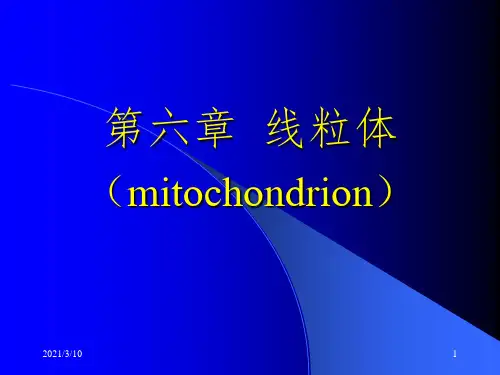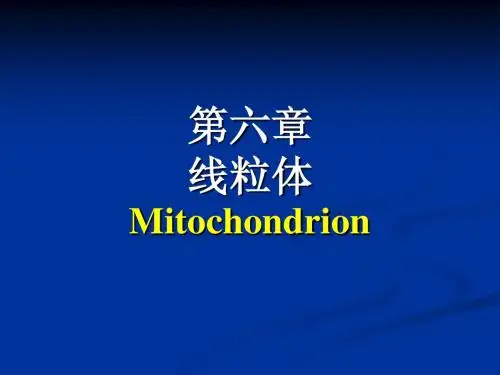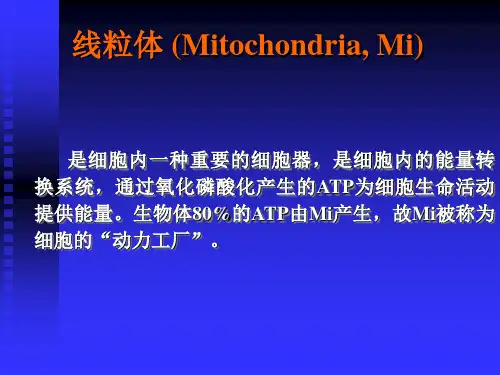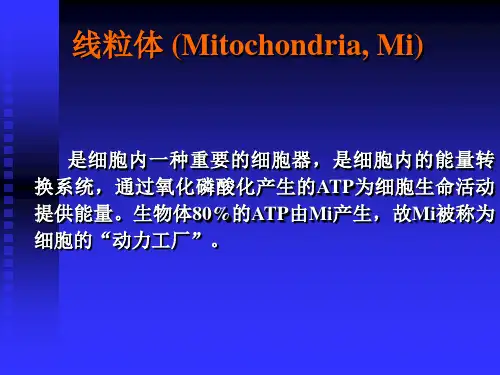第六章 线粒体 mi
- 格式:ppt
- 大小:7.50 MB
- 文档页数:47











细胞⽣物学之笔记--第6章第六章线粒体mitochondion与细胞的能量转换第⼀节线粒体的基本特征⼀、线粒体的形态、数量&结构(⼀)线粒体的形态、数量与细胞的类型和⽣理状态有关线状、粒状、杆状etc 直径0.5~1.0µm。
(⼆)线粒体是由双层单位膜套叠⽽成的封闭性膜囊结构1.外膜是线粒体外层单位膜outer membrane5~7nm厚,50%脂类、50%蛋⽩(重量)外膜蛋⽩多为转运蛋⽩,形成跨膜⽔相通道(直径2~3µm),允许分⼦量10kD以下分⼦通过,包括⼩分⼦多肽(氨基酸平均分⼦量128D)2.内膜的内表⾯附着许多颗粒inner membrane4.5nm厚,20%脂类、80%蛋⽩内腔/基质腔(matrix space)由内膜包裹的空间外腔/膜间腔(intermembrane space)内、外膜之间的空间嵴(cristae)内膜⼤量向内腔突起性折叠形成嵴间腔(intercristae space)嵴与嵴之间的内腔部分嵴内空间(intracristae space)由于嵴向内腔突起,造成的外腔向内伸⼊的部分内膜通透性很⼩,分⼦量⼤于150D,就不能通过内膜有⾼度的选择通透性,膜上转运蛋⽩控制内外腔的物质交换内膜内表⾯附着许多颗粒,数⽬:104~105个/线粒体,称基粒elementary particle =A TP合酶复合体(A TP synthase complex)3.内外膜相互接近所形成的转位接触点是物质转运到线粒体的临时性结构转位接触点translocation contact site 电镜观察揭⽰内外膜有些接触点转位接触点分布有蛋⽩质等物质进出线粒体的通道蛋⽩和特异性受体,称内膜转位⼦translocon of the inner membrane, Tim; 和外膜转位⼦translocon of the outer membrane, Tom4.基质是氧化代谢的场所基质matrix 内腔中充满的电⼦密度较低的可溶性蛋⽩质和脂肪等成分基质中含各种酶:三羧酸循环、脂肪酸氧化、氨基酸分解、蛋⽩质合成基质中含有双链环状DNA、70S核糖体有1~多个DNA拷贝,有独⽴遗传物质复制、转录、翻译5.基质的化学本质是ATP合酶基粒,⼜称A TP合酶复合体,头部直径9nm,柄部长5nm,宽4nm⼆、线粒体的化学组成三、线粒体的遗传体系(⼀)线粒体DNA构成了线粒体基因组mtDNA(mitochondrial DNA) 裸露、不与组蛋⽩结合,基质内⼀个线粒体平均5~10个DNA分⼦,编码线粒体的t RNA、rRNA及⼀些线粒体蛋⽩质但⼤多数酶和蛋⽩质仍由细胞核DNA编码,在细胞质中合成,转送到线粒体中线粒体基因组共16 569 bp,双链环状DNA,⼀条重链,⼀条轻链。